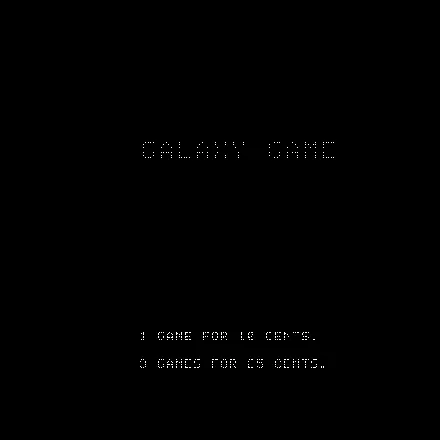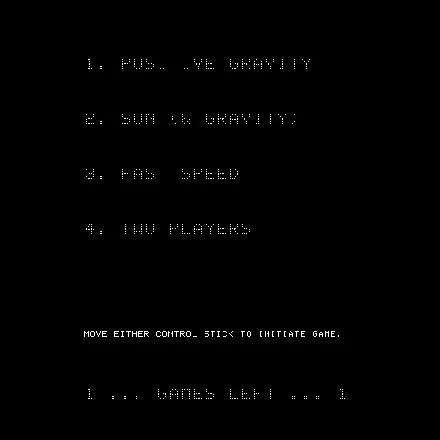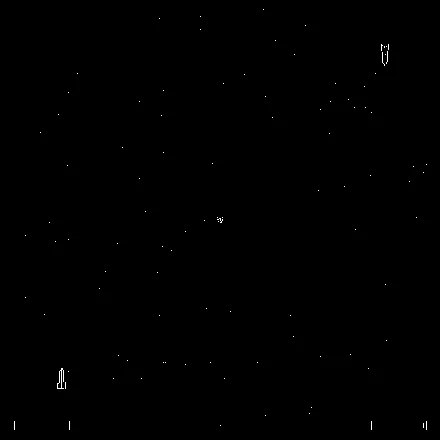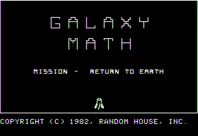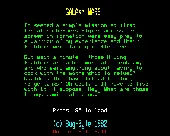Galaxy Game
Description official description
Galaxy Game is a conversion of one of the earliest video games ever produced, Spacewar. Released in September of 1971, it is the first known arcade game - beating yet another Spacewar conversion, Computer Space, by a mere two months. The game was never mass-produced and was only available at the Tresidder Union Coffee House at Stanford University.
With monochrome vector graphics, Galaxy Game is a space shooter where two players try to blow up each other's spaceship. Besides firing, players can rotate their ships left and right, thrust forward, and jump to hyperspace, reappearing at a random (potentially dangerous) location. Both ships have a limited amount of fuel that is consumed over time and as the players use their engines and the hyperspace ability. A ship explodes when it runs out of fuel.
One of the most interesting gameplay elements of the game is the gravitational pull caused by a star in the middle of the screen, which both players must avoid colliding into. However, this feature can be disabled by setting one of the machine's control switches.
The game also features a single-player mode for practice.
Groups +
Screenshots
Credits (Arcade version)
5 People
| Re-programmed by | |
| Original concept by |
Reviews
Players
Average score: 2.7 out of 5 (based on 9 ratings with 1 reviews)
The Good
When making an arcade port of the popular mainframe game Spacewar, Bill Pitts and Hugh Tuck decided to try to make the game as faithful as possible to the original. They purchased a full PDP-11 minicomputer to run the game, allowing them to run the complex physics and use real star positioning for the backdrop. They also allowed for many variations on the physics, such as positive, negative, or absent gravity from the star in the centre, or having the screen edges either wrap around to the opposite edge or cause the ships to explode when touched.
These aspects don't seem to work in the MAME implementation, so I haven't been able to experiment with them, other than the standard wrap-around and no gravity. I have seen videos of using the gravity of the star to slingshot the ships around it, which looks fun.
You can also set the game to slow or fast speed. I can enjoy both, but I think the faster speed makes for more fun gameplay although it's more difficult to control the ship.
The realistic physics are noticeable, and you can tell they put a lot of work into making the ships move realistically.
The Bad
A couple of months after Galaxy Space released at Stanford, another Spacewar port, but much less faithful to the original, Computer Space, was released by Syzygy (which would later become Atari). Computer Space cut some corners with the implementation and was less expensive to build, and they released to a larger market. One of the changes Computer Space made was to make a one player game where the enemy was a pair of flying saucers, flying in unison, which moved in random patterns and fired at the player's ship, making the game much more frantic and more playable as a single-player game. This is something that would have improved Galaxy Game as an arcade game but would have been a departure from the original game.
The MAME implementation doesn't have any sound, so I can't comment on whether there was supposed to be sound with Galaxy Game, but the sounds in Computer Space really add a lot to the gameplay, so I must hope that there was in fact sound on Galaxy Game, but I just can't experience it on the emulation along with the other options that are missing in MAME. So, while these aren't necessarily things lacking in the original game, their lack in the MAME version makes the game less enjoyable.
The single-player mode is only considered a "practice" mode, so it isn't fair to judge its lack of AI (the other ship just travels down at a constant rate to provide a moving but predictable target, but the main gameplay was always intended to be for two players).
The Bottom Line
Galaxy Game is important for historical reasons, but it was never released to a large market and was never intended to be commercially successful, but as more of an expensive project to share an implementation of a popular mainframe game, which had limited access, with the public at Stanford. At 10 cents per game, or twenty-five cents for three games, they barely broke even.
I don't consider the game worth playing for any reason other than the historical importance. It wasn't as enjoyable as Computer Space looks (I haven't been able to find an emulator for that yet), but it was the first coin-operated video game, so it's worth trying just to see what it was like.
Arcade · by NixieLake (28) · 2022
Trivia
Development
The first unit of Galaxy Game took three and a half months to create, and its total hardware costs were around $20,000 USD. A second version of the game was built with better hardware that could power multiple cabinets, and its costs went up to $60,000 USD.
Hardware
The game ran on a PDP-11/20 computer with 8 Kbytes of memory and an optional hardware multiply/divide unit. The cabinet also included a point plotting display interface, and a Hewlett-Packard 1300A Electrostatic Display. One single computer could power two machines and, with the later upgrade of the display interface in the second version, up to 8 machines could be controlled by a single PDP-11.
Game title
As the game was a re-implementation of Spacewar, it was originally intended to retain the same name. However, being 1971, the designers were concerned with the reaction to the term "war" at the Stanford University campus. They decided to name it Galaxy Game instead.
Reception
The game was very well received by the community, with 10 to 20 players around the machines on the busiest nights, sometimes waiting for their turn for over an hour. Each game cost 10 cents, but three games could be played for 25 cents. Although successful, both versions of the game barely recouped their hardware investment.
Retirement
Galaxy Game remained in operation at the Coffee House at Tresidder Union until May of 1979. The display processor had become very unreliable and the machine was removed and disassembled. The main hardware was stored for 18 years and, in April 1997, the opportunity arose for the machine to be featured, in working condition, at the Computer History Exhibit of the Stanford University. With the work of some generous volunteers, Galaxy Game was brought back to life and made available for visitors in December 1997. In the Summer of 2000 it was transferred to the Computer History Museum in Mountain View, CA. A decade later, in August 2010, the museum loaned the game to Google, for display (and use!) at their headquarters.
Analytics
Upgrade to MobyPro to view research rankings!
Related Sites +
-
Computer Space and the Dawn of the Arcade Video Game
An article on the history of Computer Space that contains some interesting information about Galaxy Game. -
Galaxy Game at Arcade History
Additional information about the game including a cabinet picture and a (real) screenshot. -
Galaxy Game at Stanford's Computer History Exhibits page
Lots of interesting information about the game, covering its entire lifetime. -
Galaxy Game at The International Arcade Museum
Various information about the game, including some cabinet pictures. -
Galaxy Game's Wikipedia page
Additional information about the game. -
Stanford Alumni article from Bill Pitts
Bill Pitts shares his memories from his time as a Stanford student and the story of Galaxy Game. -
The Golden Age Arcade Historian
Blog entry with an in-depth interview with Bill Pitts, one of the creators of the game.
Identifiers +
Contribute
Are you familiar with this game? Help document and preserve this entry in video game history! If your contribution is approved, you will earn points and be credited as a contributor.
Contributors to this Entry
Game added by Nélio.
Game added January 23, 2014. Last modified September 21, 2023.
